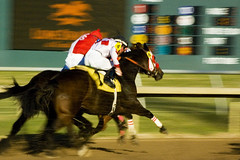Shutter speed is the speed in which the shutter opens and closes. In the pipeline analogy of previous lessons, Shutter speed is the time that elapses after you turn the spigot on and when you shut it off. In photographic terms, this could be between 1/8000th of a second and a few hours time. Of course there are photos who exceed both of those ends of the time continuum but they are pretty rare at present.
In the same way that going up another step in ISO and opening your aperture one stop can allow you to change your exposure in a precise manner, halving your shutter speed can precisely reduce your photographs exposure by one stop.
Below are typical shutter speeds by full stop change:
* 1/1000 s
* 1/500 s
* 1/250 s
* 1/125 s
* 1/60 s
* 1/30 s
* 1/15 s
* 1/8 s
* 1/4 s
* 1/2 s
* 1 s
(There is something called reciprocity failure that prove these rules untrue, but it goes back to when you re making photos that are either very very long or very very short. So for the sake of these discussions, it won't be addressed)
Now that you know that, you might be wondering how shutter speed affects your photography. The answer is, it depends. Not only does shutter speed affect exposure, but it affects how blurry or sharp your photos are. Pick a shutter speed that is too low while you try to hand hold your camera and your photo will be 'soft' or even flat out blurry.
How do you know what is a safe shutter speed? We will get into that in a later entry but for now, if you re shooting with a cropped sensor SLR (nearly all of them are) assume that if you are hand-holding your camera (no tripod, monopod, resting on a tree, etc) you need a shutter speed that is 1/1.5 times your focal length. Therefore if you are trying to shoot a photo with a 50mm lens you should maintain 1/75th of a second. If you have a 500mm lens, you should maintain 1/750th of a second, and so on. (my photography advisor recommends 1/x*2! making it 1/100!) Below are some examples The Bauer Gallery Chicken taken with different shutter speeds using a 50mm lens on a Nikon D200.

1/200th of a second @ 50mm

1/45th of a second @ 50mm

1/2 second @ 50mm
How else does shutter speed affect your photo? Well, perhaps your photo IS in focus but your subject is moving rapidly across the focal plane. This will result in a blurry photo, but, the main subject will remain sufficiently in focus. Below is an example of this effect. The subject remains acceptably in focus, while the background blurs with motion.

Hopefully now you can begin to see the relationship between shutter speed, aperture, and ISO as it related to exposure. A full step change in one should be the same as a full step in the same direction from one of the other choices. In kind, a one step decrease in one, and a one step increase in another, should render a similar exposure as your original image. In following episodes we'll explore more of the camera and how to get yourself permanently out of automatic mode and taking photos that your friends and family (and maybe even clients) will be wowed by.
TBG

